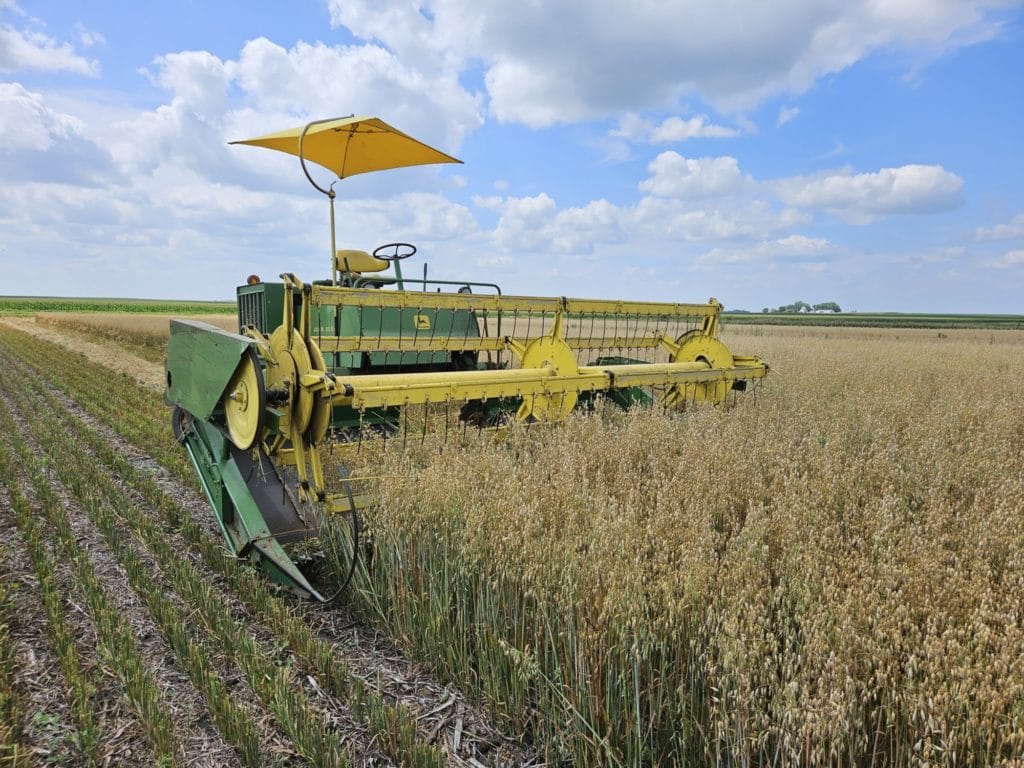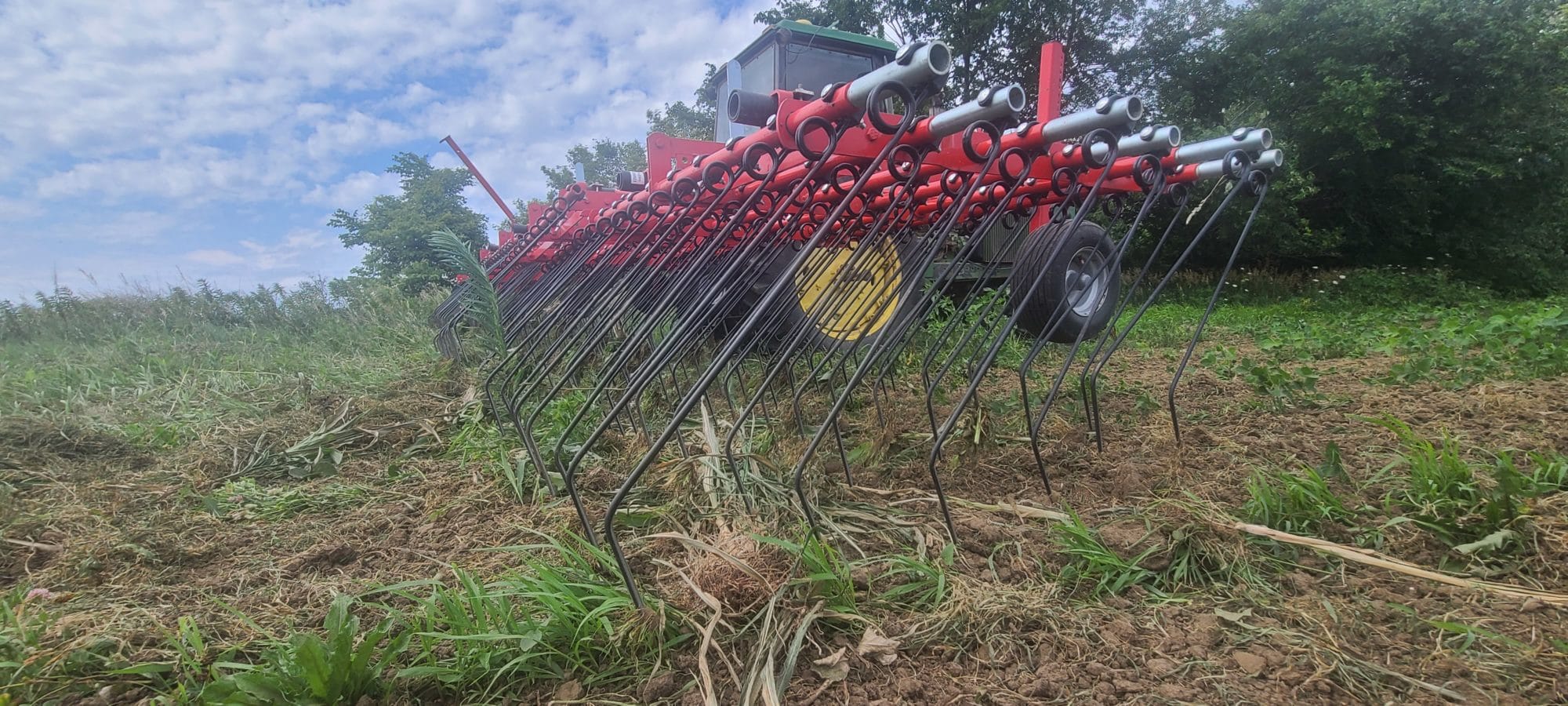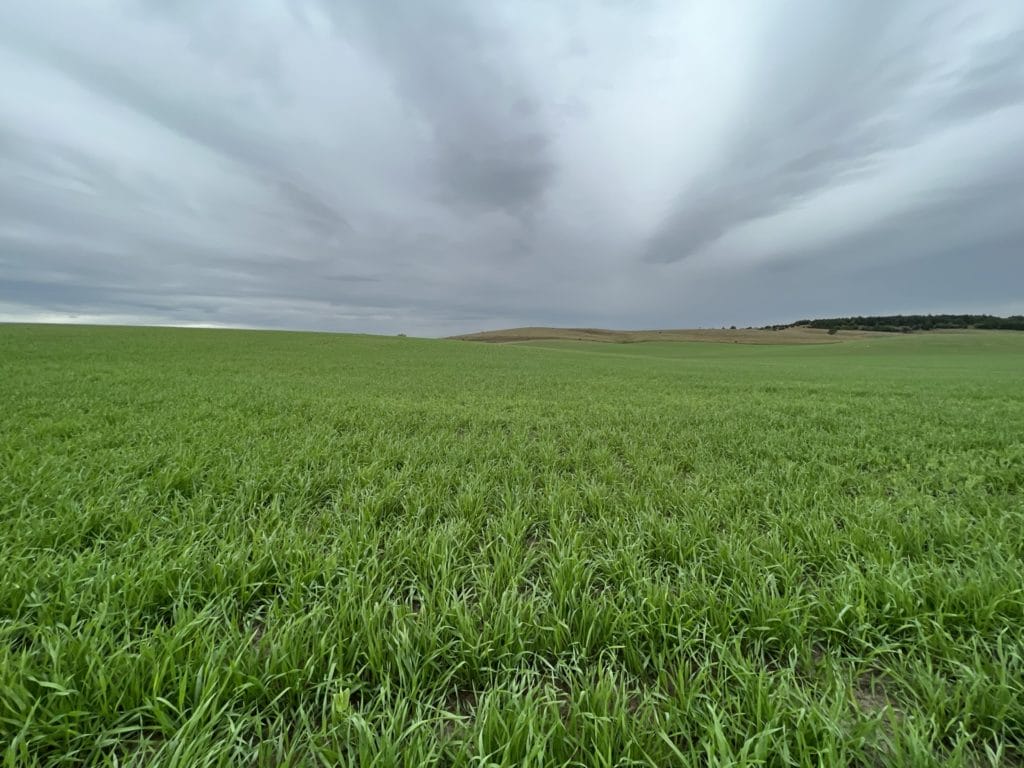Small Grains News 2023: A Year in Review
Throughout 2023, farmers shared their unique and innovative farm practices with others in our Small Grains News email newsletter. Learn about how they seed, cultivate, harvest and graze small grains on their farms. Subscribe to Small Grains News.
February 2023: J.L. Meagher
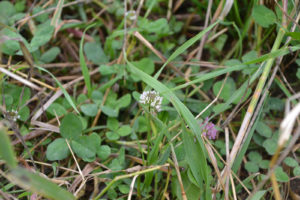 J.L. Meagher farms near Elbow Lake, Minnesota, where he raises beef cattle, horses, grows perennial pastures, hay, corn and soybeans. This year J.L. will graze his animals on 24 acres of red clover, orchard grass, alfalfa and wheat and an additional 20 acres of pasture grasses and red clover.
J.L. Meagher farms near Elbow Lake, Minnesota, where he raises beef cattle, horses, grows perennial pastures, hay, corn and soybeans. This year J.L. will graze his animals on 24 acres of red clover, orchard grass, alfalfa and wheat and an additional 20 acres of pasture grasses and red clover.
Frost-seeding red clover: J.L. frost-seeds his clover with a 3-point broadcast seeder pulled by his tractor. “If the ground is frozen I’ll go over it with the drag, but after 3-4 days you will root up potential seedlings. I usually just leave it and hope for the best.”
Grazing red clover: The red clover is typically under-seeded in pasture or hay at 3 to 4 lb/acre which is his preferred rate to balance the red clover with grasses. “When grazing early in the spring I don’t put animals out when it is wet, and I make sure they’ve had some feed in their stomach to prevent bloating.” In addition to grazing clover, J.L. can reduce nitrogen application to these fields; the red clover provides some nitrogen for the grasses in the pasture.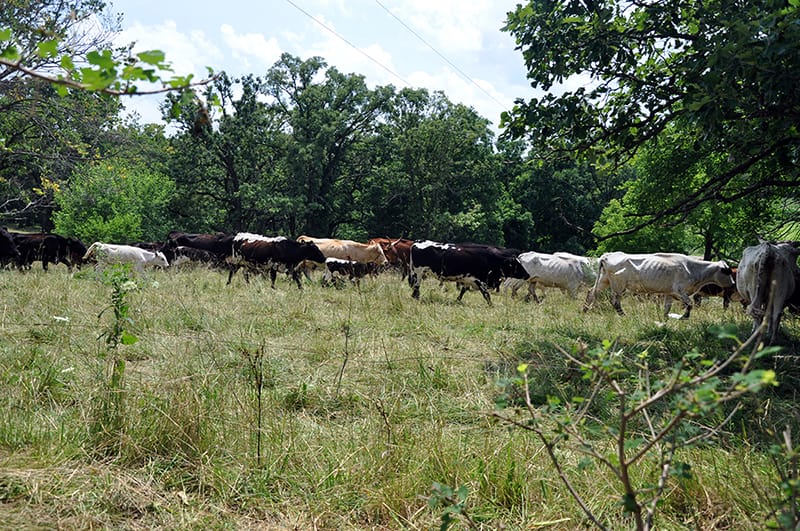
March 2023: Doug Linker
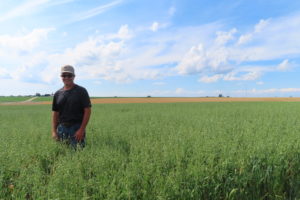 Lanark, Illinois farmer Doug Linker grows corn, soybeans and wheat. For the last four years, Doug has frost-seeded red clover into winter wheat because, with good spring establishment, it will build soil health, fix nitrogen, and provide erosion control and forage until it is terminated the next spring before corn.
Lanark, Illinois farmer Doug Linker grows corn, soybeans and wheat. For the last four years, Doug has frost-seeded red clover into winter wheat because, with good spring establishment, it will build soil health, fix nitrogen, and provide erosion control and forage until it is terminated the next spring before corn.
Spring seeding: In spring of 2022, Doug rented a Valmar air seeder from his local NRCS office to frost-seed. He seeded 10-12 lbs/ac of red clover on 171 acres into winter wheat. When planting, Doug is typically looking for a slight frost crust on the ground, that it is dry enough to get in the field and that there’s a forecast of freezethaw temperatures or snow.
Terminating red clover ahead of corn: “We have corn following wheat, so we terminate the red clover cover crop 10 days to two weeks prior to corn planting, which often falls between April 10 and 15,” says Doug. Doug grazes cattle on his clover during the fall, so by spring the clover may only be 3-4 inches tall.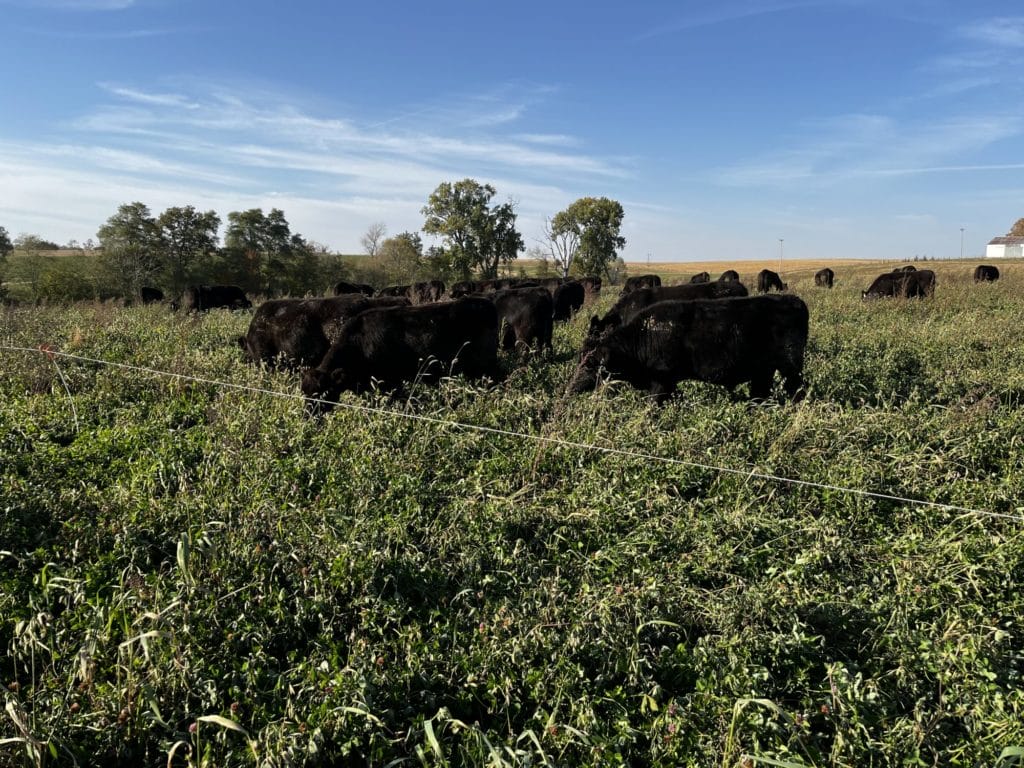
April 2023: Kellie and A.J. Blair
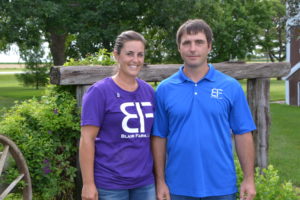 Kellie and A.J. Blair farm near Dayton, Iowa, with their two children. They started raising food-grade oats a few years ago but heard conflicting opinions on the necessity of nitrogen fertilizer for reaching test weight and maximizing the profit of food-grade oats.
Kellie and A.J. Blair farm near Dayton, Iowa, with their two children. They started raising food-grade oats a few years ago but heard conflicting opinions on the necessity of nitrogen fertilizer for reaching test weight and maximizing the profit of food-grade oats.
They decided to conduct a PFI Cooperators’ trial to evaluate what nitrogen rate would lead to maximum profit on their farm. In both years of the trial, the Blairs drilled oats into soybean stubble and applied a blend of AMS and urea roughly two weeks after planting.
In their 2020 trial, they compared zero and 50 pounds of nitrogen fertilizer per acre. They found that the fertilizer treatment had significantly higher oat yields, and even with the added expense of fertilizer, had higher profitability.
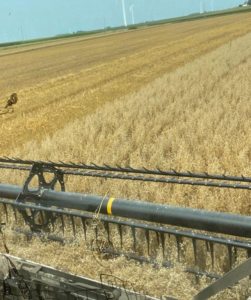 The following year, the Blairs wanted to hone their N rate further for food-grade oats, so they conducted another trial to compare rates of 25, 50 and 75 lb N/ac, expecting that the 50 lb N/ac treatment would have the most significant yield and profitability. They found that the 25 lb N/acre treatment yielded similarly to the other treatments, meaning the profit margin was higher with the lower cost of inputs.
The following year, the Blairs wanted to hone their N rate further for food-grade oats, so they conducted another trial to compare rates of 25, 50 and 75 lb N/ac, expecting that the 50 lb N/ac treatment would have the most significant yield and profitability. They found that the 25 lb N/acre treatment yielded similarly to the other treatments, meaning the profit margin was higher with the lower cost of inputs.
For more details about their production and trial, watch their virtual field day recording on growing high-quality food-grade oats.
May 2023: Margaret Smith and Doug Alert
 Clover plays a key role in Doug Alert and Margaret Smith’s organic corn-soybean-small grain rotation. The Hampton, IA farmers frost-seed red clover into winter grain crops and, for spring small grains, drill clover with the small grain. They tend to use red clover because of its reliability but have been testing sweet clover as well.
Clover plays a key role in Doug Alert and Margaret Smith’s organic corn-soybean-small grain rotation. The Hampton, IA farmers frost-seed red clover into winter grain crops and, for spring small grains, drill clover with the small grain. They tend to use red clover because of its reliability but have been testing sweet clover as well.
Organically terminating clover: Determining when and how to terminate their clover has been a decades-long process of experimentation, and Doug reports an evolution from fall plowing, to spring plowing followed by cultipacking, to disking (fall, then again in the spring), and for the past three years, rotovating. Doug rotovates 3” deep, which accomplishes one-pass termination and leaves a mulch of plant material on the soil surface. It’s a slow operation but considering the time it takes to do multiple passes using different tools, clover termination is ultimately quicker.
Weighty decisions: To avoid infestation from seed corn maggots, cutworms and armyworms, Margaret and Doug have found that the best window to terminate clover is three weeks prior to corn planting. But, Margaret says, “May is a period of rapid legume growth and N fixation so we’re always giving up some nitrogen-fixation when we terminate three weeks early.”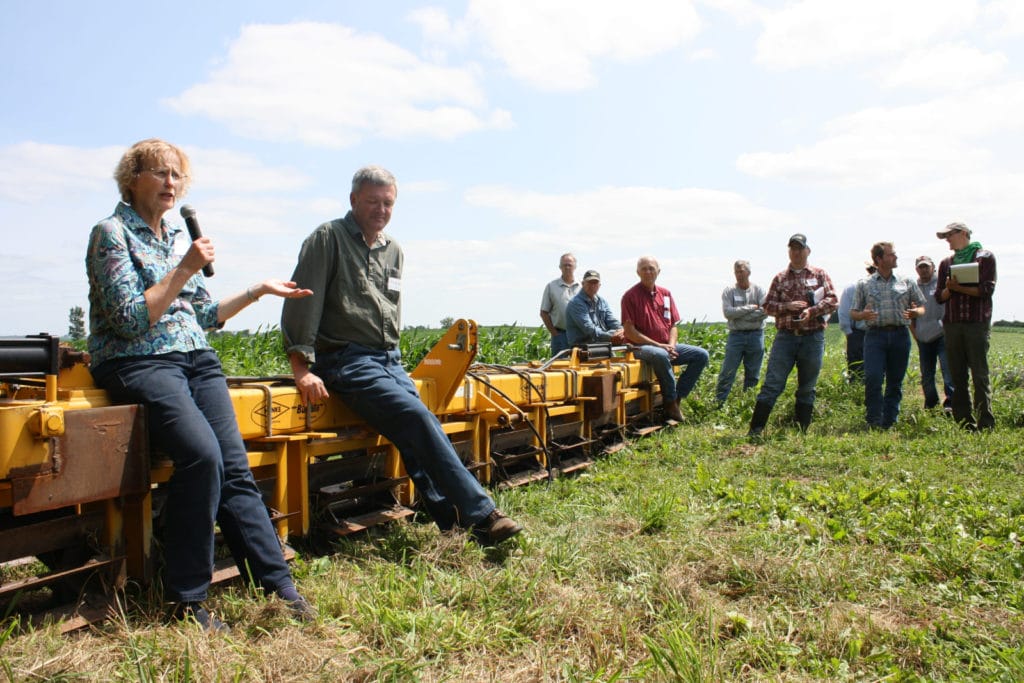
June 2023: Ross and Cassie Kurash
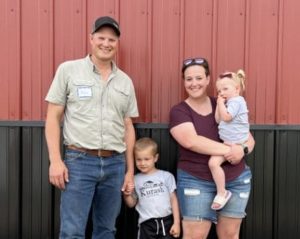 Ross Kurash, a 5th generation farmer, farms in northeast Iowa with his wife Cassie Kurash and their two kids. Ross emphasizes the importance of including diverse crop rotations, year-round cover, no-till and animal integration for building water-retentive and nutrient-dense soil.
Ross Kurash, a 5th generation farmer, farms in northeast Iowa with his wife Cassie Kurash and their two kids. Ross emphasizes the importance of including diverse crop rotations, year-round cover, no-till and animal integration for building water-retentive and nutrient-dense soil.
Keep it covered: Ross rotationally grazes 25 beef cows, 15 yearling calves and 15 finishers on his farm. He seeds forage crops twice in the summer: once in early June after cows have grazed the fallseeded rye and again following rye harvest in late July. The June-seeded mix includes oats, buckwheat, cowpeas, Sunn hemp, Japanese millet, sorghum-sudangrass, rapeseed and sunflower. His later summer mix contains an even more diverse array which includes chickling and common vetch, berseem clover, lentil and Daikon radish in addition to oats, buckwheat, cowpeas and Sunn hemp. For both mixes, Ross no-till drills about 45 pounds per acre at 7.5-inch spacings.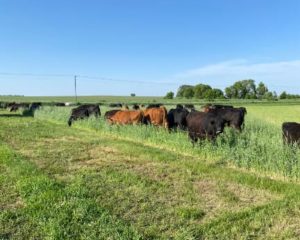
Happy cows, healthy soil: Last year, Ross was able to strip graze 40,000 pounds of cattle on his 15 acres of summer cover and 30 acres of corn residue for the month of December without supplementing with any additional feed. Between the constant cover, diversity of plants and addition of manure, his most recent microscopic soil analysis found beneficial life and micro-organisms not typically found in agricultural fields.
July 2023: Neil Peterson
 Neil Peterson farms near Fonda, Iowa, tending corn, soybeans, oats, hay and row crop ground converted to pasture for his 50 beef cattle. As a participant in PFI’s cooperators’ program, he is trialing four oat varieties- Saddle, Reins, South Dakota Buffalo and Minnesota Pearl- across 20 acres.
Neil Peterson farms near Fonda, Iowa, tending corn, soybeans, oats, hay and row crop ground converted to pasture for his 50 beef cattle. As a participant in PFI’s cooperators’ program, he is trialing four oat varieties- Saddle, Reins, South Dakota Buffalo and Minnesota Pearl- across 20 acres.
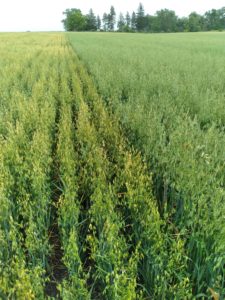 Exploring oat varieties: In early April, Neil no-till drilled oats into soybean stubble with 7.5 inches of spacing at a rate of 110 pounds per acre. Relying on cattle manure spread last fall for fertility, he chose to limit the use of synthetic inputs for his oats this year in hopes of finding the variety that performs best without synthetic inputs. On Neil’s farm, the Reins and Saddle varieties matured first. SD Buffalo and MN Pearl varieties matured later and were the tallest.
Exploring oat varieties: In early April, Neil no-till drilled oats into soybean stubble with 7.5 inches of spacing at a rate of 110 pounds per acre. Relying on cattle manure spread last fall for fertility, he chose to limit the use of synthetic inputs for his oats this year in hopes of finding the variety that performs best without synthetic inputs. On Neil’s farm, the Reins and Saddle varieties matured first. SD Buffalo and MN Pearl varieties matured later and were the tallest.
Harvest time: Despite slight variations in height and maturity, Neil decided to harvest all his oats at the same time, in late July, using a swather to dry the oat grain and straw out before combining. This year, his oat yield was approximately 126 bushels per acre, which was higher than expected considering ongoing dry conditions and a definite improvement from last year. He plans to sell some of the grain as livestock feed and keep the rest for personal on-farm use as cover crop seed and cattle feed.
August 2023: Ross McCaw
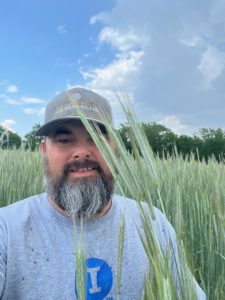 As fall approaches, many farmers prepare to plant their overwintering small grains. Ross McCaw, who farms corn, soybeans, and cereal rye near Marengo, IA is gearing up to plant his cereal rye the third week of September.
As fall approaches, many farmers prepare to plant their overwintering small grains. Ross McCaw, who farms corn, soybeans, and cereal rye near Marengo, IA is gearing up to plant his cereal rye the third week of September.
Drilling early: When planting a rye grain crop, Ross seeds the rye immediately after harvesting his early-maturity soybeans. He will plant Aroostook rye which he prefers for its speedy maturity and tall height. The rye will be drilled in 10-inch rows using a 40-foot 1990 John Deere CCS drill. On his 2023 rye, he spread chicken manure as fertilizer for the first time and plans to continue this process after experiencing positive results.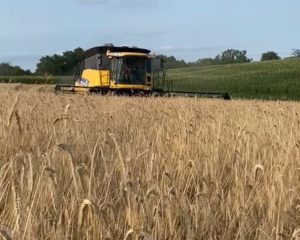
Practices to increase tillering: Next spring, Ross plans to plant 1.8 maturity group soybeans so he can harvest earlier and then promptly drill cereal rye. The earlier planting date should enable more tillering before the rye goes dormant, increasing yield in the subsequent harvest. Ross also hopes to gain more tillering by applying nitrogen this fall rather than in the spring. An added perk of applying nitrogen in the fall is that the rye plants will be smaller and more supple and less likely to be damaged by the application equipment.
September 2023: Daniel and Emily Sheetz
 Daniel and Emily Sheetz have been farming organically near Toledo, Iowa, for about 15 years and recently decided to grow winter wheat after trying out food-grade oats and soft red spring wheat which yielded poorly. With a higher price, Daniel found that winter wheat brings in double the profit of oats, even with comparable yields.
Daniel and Emily Sheetz have been farming organically near Toledo, Iowa, for about 15 years and recently decided to grow winter wheat after trying out food-grade oats and soft red spring wheat which yielded poorly. With a higher price, Daniel found that winter wheat brings in double the profit of oats, even with comparable yields.
Variety matters: Despite initially being hesitant to try growing winter wheat in Iowa due to humidity and disease concerns, Daniel has found a variety – Wesley Hard Red Winter Wheat – suitable for their farm. “Last fall, I probably only had an inch or two of growth on the wheat, but there was enough growth to get through the winter, and it took off in the spring much better than my oats did.”
Planning for weed control: Immediately after soybean harvest in mid-October, Daniel will plant the next winter wheat crop in 7.5-in. spacings at a rate of 2-2.5 bu/ac. He plans to use an Einbach 12-row Aerostar tine weeder in the spring to remove weed competition from the first half-inch of soil for the young tillering wheat crop. That will reduce the need for tillage prior to seeding a cover crop following wheat harvest.
October 2023: Clay, Logan and Frank Govier
 On their farm near Broken Bow, Nebraska, brothers Clay and Logan Govier and their father, Frank, have been busy harvesting soybeans and corn and drilling in cereal rye on mornings when it’s too wet to harvest. Though much of that rye is cover crop, approximately 15 percent will be harvested for grain next year and sold either as cover crop seed or to Sideshow Distillery in Lincoln, Nebraska.
On their farm near Broken Bow, Nebraska, brothers Clay and Logan Govier and their father, Frank, have been busy harvesting soybeans and corn and drilling in cereal rye on mornings when it’s too wet to harvest. Though much of that rye is cover crop, approximately 15 percent will be harvested for grain next year and sold either as cover crop seed or to Sideshow Distillery in Lincoln, Nebraska.
Saving on equipment: Due to the arid conditions in central Nebraska, the Goviers, like other farmers in the area, use pivot irrigation. This provides a unique opportunity to fertilize without making an extra pass using other equipment. When the chance of freezing temperatures has passed in spring, they will apply a blend of nitrogen, sulfur, boron, and humic acid to their rye through the pivot system.
Reducing inputs: The Goviers’ foray into growing cereal rye as a cover crop and grain resulted from working to find ways to reduce purchased inputs in the future. They have already found that yellow field peas are quite effective at fixing nitrogen.
“We’ve grown 50 or 60 bushels of rye after peas with zero fertilizer. I can seed it the second half of August and get a lot of tillering in the fall,” says Clay.

